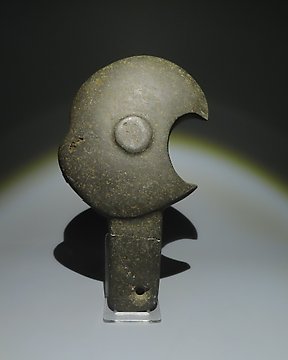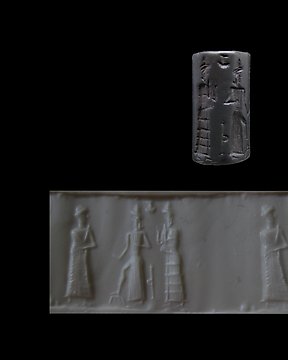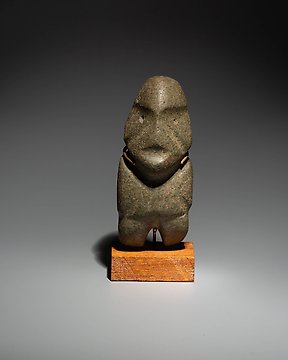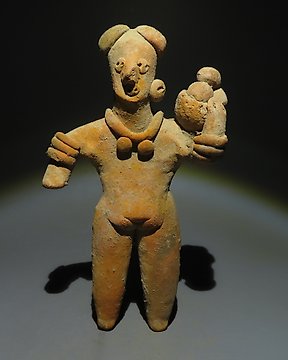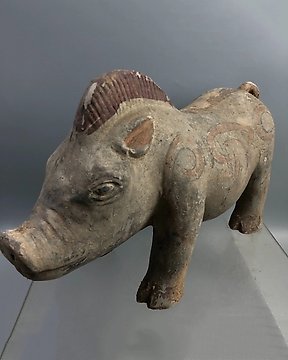conforme rapide hope other thanks ++++
Vertaling bekijkenOud-Egyptisch Steen SCARAB-GODIN HATHOR. 1,5 cm H. Beste kwaliteit. Ex. Antonovich-collectie.
Nr. 85409493


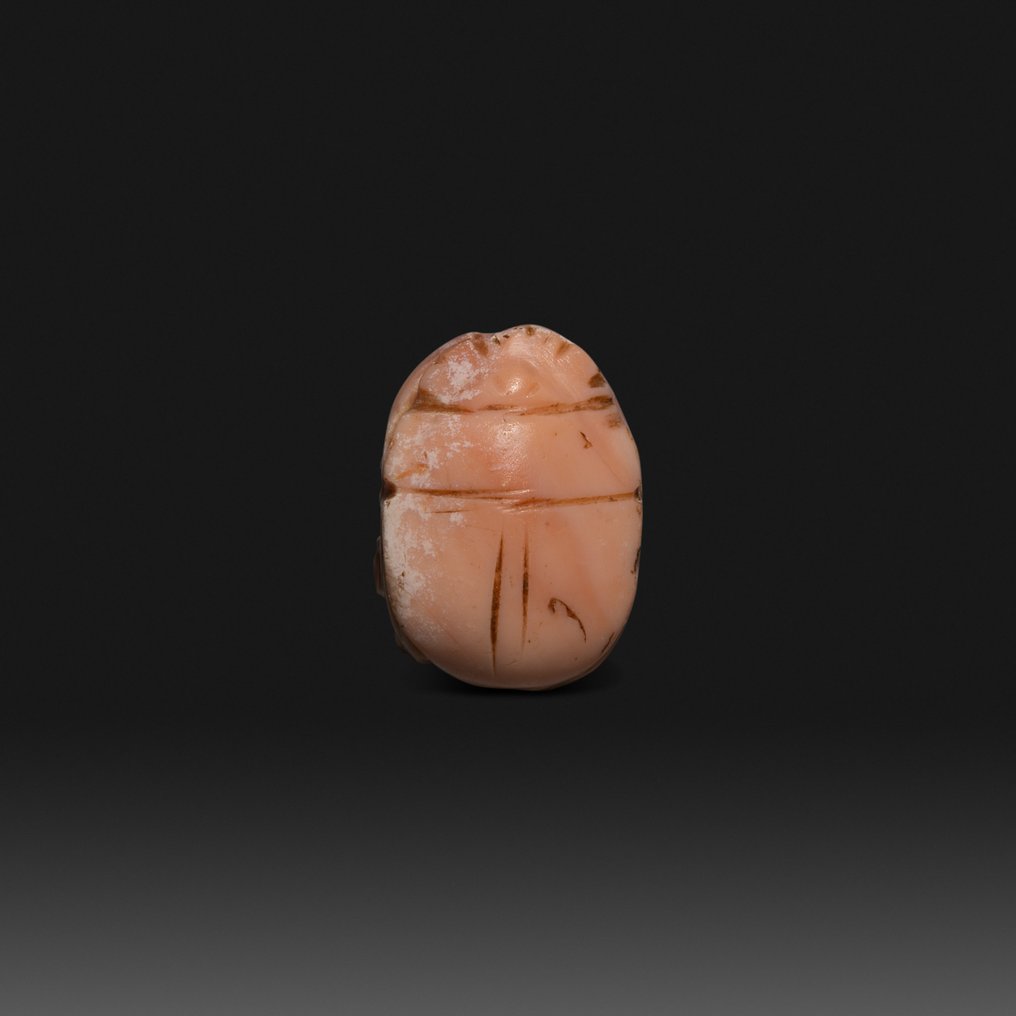
SCARAB WITH THE GODDESS HATHOR
- nice quality -
Ancient Egypt, Late Period, 664 - 323 B.C.
Stone
Height 1.5 cm
CONDITION: Intact.
PROVENANCE: Private collection, François Antonovich, Paris, France. Sold by judicial auction in 2022.
DOCUMENTS: Provided of a certificate of authenticity and export license by the Ministry of Culture.
Scarab-shaped amulet, called scarab, carved in carnelian. The upper part represents the animal in a naturalistic way, with the elytra differentiated and the head and legs reflected in detail. The scarab is placed on a flat base, decorated by incision and sunken relief with the image of the goddess Hathor identified by her characteristic headdress with cow horns. The deity appears seated in profile to the left with his torso facing forward, on a throne with a low back, in front of a vertical plant element. The image is framed by a simple oval line. The scarab is perforated longitudinally, which would allow it to be held with a cord or attached to a ring.
The scarab, a scarab-shaped amulet, is the most widespread form of Egyptian amulets both in the funerary context and in daily life. The oldest found, made of ivory, dates from the VI dynasty (c. 2345-2171 BC). The scarabs were represented in various materials: soapstone, basalt, granite and in precious stones such as lapis lazuli, amethyst, carnelian, and even in metals such as gold. In this case, in green jasper. They are generally small and pierced to allow them to be attached to a necklace, and at the base they carry a brief inscription or mythological, human or animal figures.
Symbol of the cycle of constant transformation of life, the scarab was linked to the god Jepri, form of Ra as the rising sun. The Egyptians believed that Jepri transported the Sun every day after its disappearance on the horizon, through the underground world or Duat, to make it reborn again the next day. The scarab was therefore an amulet of life and power, a representation of the rising Sun and a fundamental symbol of protection. Its importance has determined that numerous examples reach our days, which have allowed it to be studied in depth. In life, the scarab provided protection against visible and invisible evil, and daily granted strength and power to its possessor. In death, it granted the possibility of resurrection in the Afterlife and achieving eternal life.
In this funeral context, the so-called heart scarab stands out, which was placed on the chest of the deceased to protect his heart and even replace this organ if it was damaged in the mummification process. Used from the Middle Kingdom onwards, it soon became one of the most important amulets in the mummification process and funerary rituals. Starting at the end of the New Kingdom, when the heart scarab reached its greatest popularity, it began to be represented with wings, which symbolize the protection it offers. Other smaller scarabs were used in life individually or in groups, inserted in a pectoral collar structure, with the same protective function although not necessarily of a funerary type. These small scarabs also appear very frequently in rings of solar symbology, linked to the god Ra. On the other hand, a multitude of them have been found with the names of pharaohs inscribed on their base, often linked to the funerary temples of the characters they allude to but also used as protective amulets, which invoked the power of deified deceased pharaohs.
The use of amulets has been documented in Egypt as early as the Predynastic period, in the Badarian Neolithic culture (c. 4400-3800 BC). Inscribed lists have been found such as that of the Temple of Dendera or that of the so-called McGregor papyrus, where some 75 different models of amulets are cited with their form, function, meaning and signifier. They were symbolic objects that gave their possessor protection or power in the face of the world of chaos and in the journey to the Beyond. Through the word - key in ancient Egyptian culture - and appropriate rituals, the amulets were imbued with magical powers that gave them their protective function; They were therefore subjected to a kind of act of consecration that gave an inanimate object divine characteristics.
Notes:
- The piece includes authenticity certificate.
- The piece includes Spanish Export License (Passport for European Union) - If the piece is destined outside the European Union a substitution of the export permit should be requested, can take between 1-2 weeks maximum.
- The seller guarantees that he acquired this piece according to all national and international laws related to the ownership of cultural property. Provenance statement seen by Catawiki.
#alienscollection
De verkoper stelt zich voor
SCARAB WITH THE GODDESS HATHOR
- nice quality -
Ancient Egypt, Late Period, 664 - 323 B.C.
Stone
Height 1.5 cm
CONDITION: Intact.
PROVENANCE: Private collection, François Antonovich, Paris, France. Sold by judicial auction in 2022.
DOCUMENTS: Provided of a certificate of authenticity and export license by the Ministry of Culture.
Scarab-shaped amulet, called scarab, carved in carnelian. The upper part represents the animal in a naturalistic way, with the elytra differentiated and the head and legs reflected in detail. The scarab is placed on a flat base, decorated by incision and sunken relief with the image of the goddess Hathor identified by her characteristic headdress with cow horns. The deity appears seated in profile to the left with his torso facing forward, on a throne with a low back, in front of a vertical plant element. The image is framed by a simple oval line. The scarab is perforated longitudinally, which would allow it to be held with a cord or attached to a ring.
The scarab, a scarab-shaped amulet, is the most widespread form of Egyptian amulets both in the funerary context and in daily life. The oldest found, made of ivory, dates from the VI dynasty (c. 2345-2171 BC). The scarabs were represented in various materials: soapstone, basalt, granite and in precious stones such as lapis lazuli, amethyst, carnelian, and even in metals such as gold. In this case, in green jasper. They are generally small and pierced to allow them to be attached to a necklace, and at the base they carry a brief inscription or mythological, human or animal figures.
Symbol of the cycle of constant transformation of life, the scarab was linked to the god Jepri, form of Ra as the rising sun. The Egyptians believed that Jepri transported the Sun every day after its disappearance on the horizon, through the underground world or Duat, to make it reborn again the next day. The scarab was therefore an amulet of life and power, a representation of the rising Sun and a fundamental symbol of protection. Its importance has determined that numerous examples reach our days, which have allowed it to be studied in depth. In life, the scarab provided protection against visible and invisible evil, and daily granted strength and power to its possessor. In death, it granted the possibility of resurrection in the Afterlife and achieving eternal life.
In this funeral context, the so-called heart scarab stands out, which was placed on the chest of the deceased to protect his heart and even replace this organ if it was damaged in the mummification process. Used from the Middle Kingdom onwards, it soon became one of the most important amulets in the mummification process and funerary rituals. Starting at the end of the New Kingdom, when the heart scarab reached its greatest popularity, it began to be represented with wings, which symbolize the protection it offers. Other smaller scarabs were used in life individually or in groups, inserted in a pectoral collar structure, with the same protective function although not necessarily of a funerary type. These small scarabs also appear very frequently in rings of solar symbology, linked to the god Ra. On the other hand, a multitude of them have been found with the names of pharaohs inscribed on their base, often linked to the funerary temples of the characters they allude to but also used as protective amulets, which invoked the power of deified deceased pharaohs.
The use of amulets has been documented in Egypt as early as the Predynastic period, in the Badarian Neolithic culture (c. 4400-3800 BC). Inscribed lists have been found such as that of the Temple of Dendera or that of the so-called McGregor papyrus, where some 75 different models of amulets are cited with their form, function, meaning and signifier. They were symbolic objects that gave their possessor protection or power in the face of the world of chaos and in the journey to the Beyond. Through the word - key in ancient Egyptian culture - and appropriate rituals, the amulets were imbued with magical powers that gave them their protective function; They were therefore subjected to a kind of act of consecration that gave an inanimate object divine characteristics.
Notes:
- The piece includes authenticity certificate.
- The piece includes Spanish Export License (Passport for European Union) - If the piece is destined outside the European Union a substitution of the export permit should be requested, can take between 1-2 weeks maximum.
- The seller guarantees that he acquired this piece according to all national and international laws related to the ownership of cultural property. Provenance statement seen by Catawiki.
#alienscollection
De verkoper stelt zich voor
- 749
- 7
- 0
Különleges eszköz, jó állapotban van, köszönöm a rendkívül gyors szállítást. Ajánlom az Eladót!
Vertaling bekijkenfast delivery, good packaging
Vertaling bekijkenGood seller: fast shipment, good packing and a very nice object. Thank you!
Vertaling bekijkensuper 💯💯💯💯💯
Vertaling bekijkenIl pezzo è arrivato in condizioni perfette il pacco era protetto alla perfezione
Vertaling bekijkenBuenos días, señor. ¡Gracias por las precauciones de embalaje Tip / Top! Muy contento con mi compra. ¡Gracias!
Vertaling bekijkenPerfecto! :)
Vertaling bekijkenWunderbares Stück. Alles wie beschrieben. Hervorragender Kontakt.
Vertaling bekijkenExtremely rapid courrier service from Barcelona to Flanders, picture was nicely and carefully packaged. Muchas gracias!
Vertaling bekijkenVery fine specimen! Thanks.
Vertaling bekijkengoede foto's, goede omschrijving, goed verpakt en snel verzonden.
Vertaling bekijkenmolto bello tutto ok
Vertaling bekijkenPezzo come da descrizione, davvero notevole. Venditore molto consigliato in quanto gentile e disponibile. spedizione molto veloce. Ottimo!
Vertaling bekijkenVenditore davvero ottimo e gentile. Merce come da descrizione, spedizione veloce. Ottimo l'avere certificato di autenticità.
Vertaling bekijkenUn 100 como empresa un 100 como envío . Empresa muy especial con mucha exquisitez en todos los productos y en personal . Muchas gracias
Vertaling bekijkenAll well! Thanks.
Vertaling bekijkenVery nice and fine cut little jewel! Well packed too! Thanks!
Vertaling bekijkennice piece and very fast shipping!
Vertaling bekijkenEs una maravilla de moneda, donde se le nota los pasos de los años y me encanta. Servido muy rápido y bien empaquetado. Con su certificación. Qué más se puede pedir?
Vertaling bekijkenSnelle en correcte levering, alleen was de verpakking voor het schilderij niet stevig genoeg.
Vertaling bekijkenHerzlichen Dank!
Vertaling bekijkenAll OK and with very fast shipping.
Vertaling bekijkenPrachtig schilderij. Zo blij mee. Zeer nette verkoper en zeer snelle levering.
Vertaling bekijken- 749
- 7
- 0
conforme rapide hope other thanks ++++
Vertaling bekijkenDisclaimer
De verkoper garandeert dat het object legaal is verkregen en kan dit bewijzen. Catawiki heeft de verkoper geïnformeerd dat hij/zij documentatie moet overleggen die vereist is volgens de wetten in hun land van verblijf. De verkoper garandeert dat hij/zij toestemming heeft om het object te verkopen/exporteren. De verkoper zal alle over het object bekende herkomstgegevens aan de koper verstrekken. De verkoper zorgt ervoor dat eventueel benodigde vergunningen zijn/zullen worden geregeld. De verkoper zal de koper onmiddellijk informeren over eventuele vertragingen bij het verkrijgen van dergelijke vergunningen.
De verkoper garandeert dat het object legaal is verkregen en kan dit bewijzen. Catawiki heeft de verkoper geïnformeerd dat hij/zij documentatie moet overleggen die vereist is volgens de wetten in hun land van verblijf. De verkoper garandeert dat hij/zij toestemming heeft om het object te verkopen/exporteren. De verkoper zal alle over het object bekende herkomstgegevens aan de koper verstrekken. De verkoper zorgt ervoor dat eventueel benodigde vergunningen zijn/zullen worden geregeld. De verkoper zal de koper onmiddellijk informeren over eventuele vertragingen bij het verkrijgen van dergelijke vergunningen.
